Table of Contents
- Market Size
- Regional Analysis
- Top Artificial Intelligence Statistics
- Artificial Intelligence Statistics – Usage
- Artificial Intelligence Statistics – Business
- Artificial Intelligence Statistics – Sales
- Artificial Intelligence Statistics – Marketing
- Artificial Intelligence Statistics – Customer Service
- Benefits of Artificial Intelligence Adoption Statistics
- AI’s Impact on Employment Statistics
- Recent Developments
- Conclusion
- FAQ’s
Artificial Intelligence Statistics: Artificial intelligence (AI) is the simulation of human intelligence in machines engineered to think and learn like humans.
It entails creating computer systems that can execute tasks that normally need intellect from humans. Such as visual perception, speech recognition, decision-making, problem-solving, and language translation.
There are two forms of AI: narrow AI and general AI. Narrow AI, commonly referred to as weak AI, is intended to execute specified tasks within a narrow scope.
Voice assistants such as Siri and Alexa are examples, as are image recognition systems and recommendation engines.
General AI, on the other hand, refers to AI systems that, like human intelligence, can understand, learn, and apply knowledge across different disciplines.
Machine Learning (ML) is a subfield of AI that focuses on algorithms and statistical models that enable computers to learn from and make predictions or decisions based on data.
Deep Learning is a subset of ML that uses neural networks with many layers to learn and represent complex patterns and relationships in data.
The current market research on artificial intelligence indicates that even though several companies fall behind in AI adoption. Some have taken to the technology, coming up with innovative uses for it.
Artificial intelligence is used in business applications that cover fields like customer service, marketing, and sales. All of which had previously been viewed as lengthy and labor-intensive procedures. AI applications have led to an increase in productivity and profit.
For instance, the current business intelligence data reflect the constant growth in the demand for these products. Which makes it probable that the future is promising for this technology.
Market Size
The Global Artificial Intelligence Market size is expected to be worth around USD 2,745 billion by 2032, from USD 177 Billion in 2023. Growing at a CAGR of 36.8% during the forecast period from 2024 to 2033.
Between 2020 and 2022, the annual corporate investments in AI startups grew to five billion U.S. dollars. Nearly triple the previous investment and a large portion of it being private investment from U.S. companies.
Most recent high-end AI companies include all chatbot and machine learning businesses that focus on human-machine interfaces.
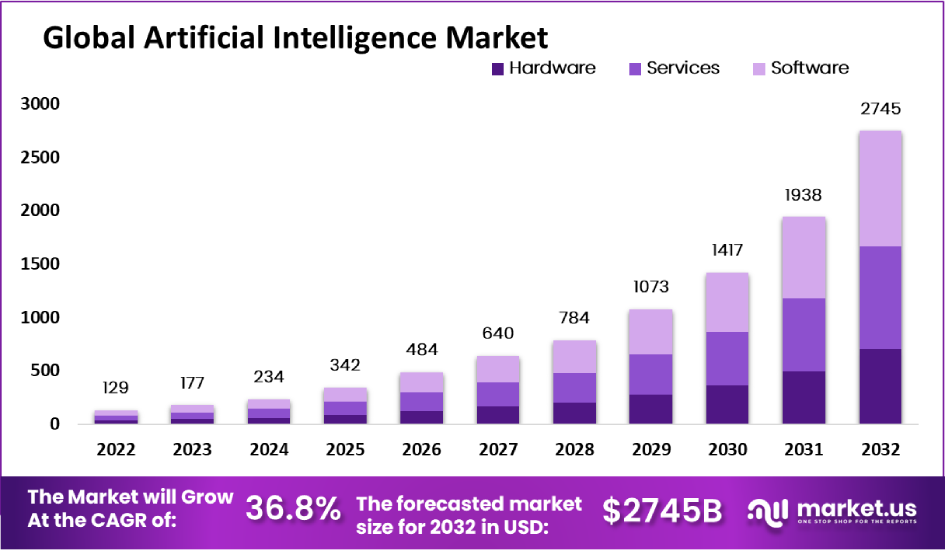
(Source: Statista)
Regional Analysis
North America
North America, notably the United States, has been a leading force in artificial intelligence. It is home to world-class technology giants. Such as Google, Microsoft, and IBM, all of which have made important contributions to AI research and development.
The region also features notable universities known for their AI programs, such as Stanford and MIT. The US has a vibrant AI startup ecosystem, particularly in Silicon Valley, which attracts talent and funding.
Europe
Europe has also made significant strides in AI research and development. Countries such as the United Kingdom, Germany, France, and Sweden have led the way in AI innovation.
The European Union has made investments in artificial intelligence through initiatives such as the European AI Strategy and the construction of AI research institutes. Europe also prioritizes ethical and responsible AI development, with an emphasis on privacy, justice, and transparency.
Asia
Asia especially China has become a major actor in AI. China has made significant investments in AI study and innovation, to be the world’s leader in AI in 2030.
Chinese companies such as Baidu, Alibaba, and Tencent have made major progress on AI in recent years and enjoy a solid presence on the market. Other nations located in Asia including Japan as well as South Korea, also have impressive AI technology for research and development.
Canada
Canada has earned its reputation as a major hub in AI research and advancement. It has made substantial investments in AI which have led to the development of world-class research institutions and AI-focused startups.
In particular, the University of Toronto and the Montreal Institute for Learning Algorithms (MILA) are well-known for their contribution to the field. Canada’s immigration policies are favorable and have drawn the best AI talent from all over the globe.
Other regions
Other regions, like Australia as well as New Zealand, have been active in AI Research and Development. Australia has seen an increase in AI investment and startups especially in areas such as natural computer vision and language processing.
In the Middle East, countries like Israel and the United Arab Emirates have shown an interest in AI which has encouraged collaboration and innovation.
Top Artificial Intelligence Statistics
- The artificial intelligence (AI) software market is expanding at a rapid pace and the most recent market forecast for artificial intelligence. For instance, indicates that the industry is fueled by the increase in the use cases for this category. But, the growth isn’t limited to the software sector and AI is also predicted to have an impact on the economy. Here are some important data on the market for artificial intelligence that you need to be aware of.
- $15.7 trillion projected AI impact on the world economy in 2030. This is an increase of 26% in GDP globally for the same period.
- The AI market size of the industry is estimated to reach $266.92 billion by 2027.
- The projected growth rate of the AI market’s compound annual growth rate between 2020 and 2027 is 33.2%.
- North America is expected to hold the most AI market part.
- The retail industry is set to grow significantly, with 80% of business leaders affirming that their companies will implement AI technology from 2020 until 2027.
- The market for hardware driven by AI is expected to reach $234.6 billion by 2025.
- The small number of AI experts is thought as a major hindrance to the AI market’s development.
(Source: World Economic Forum 2020, Statista)
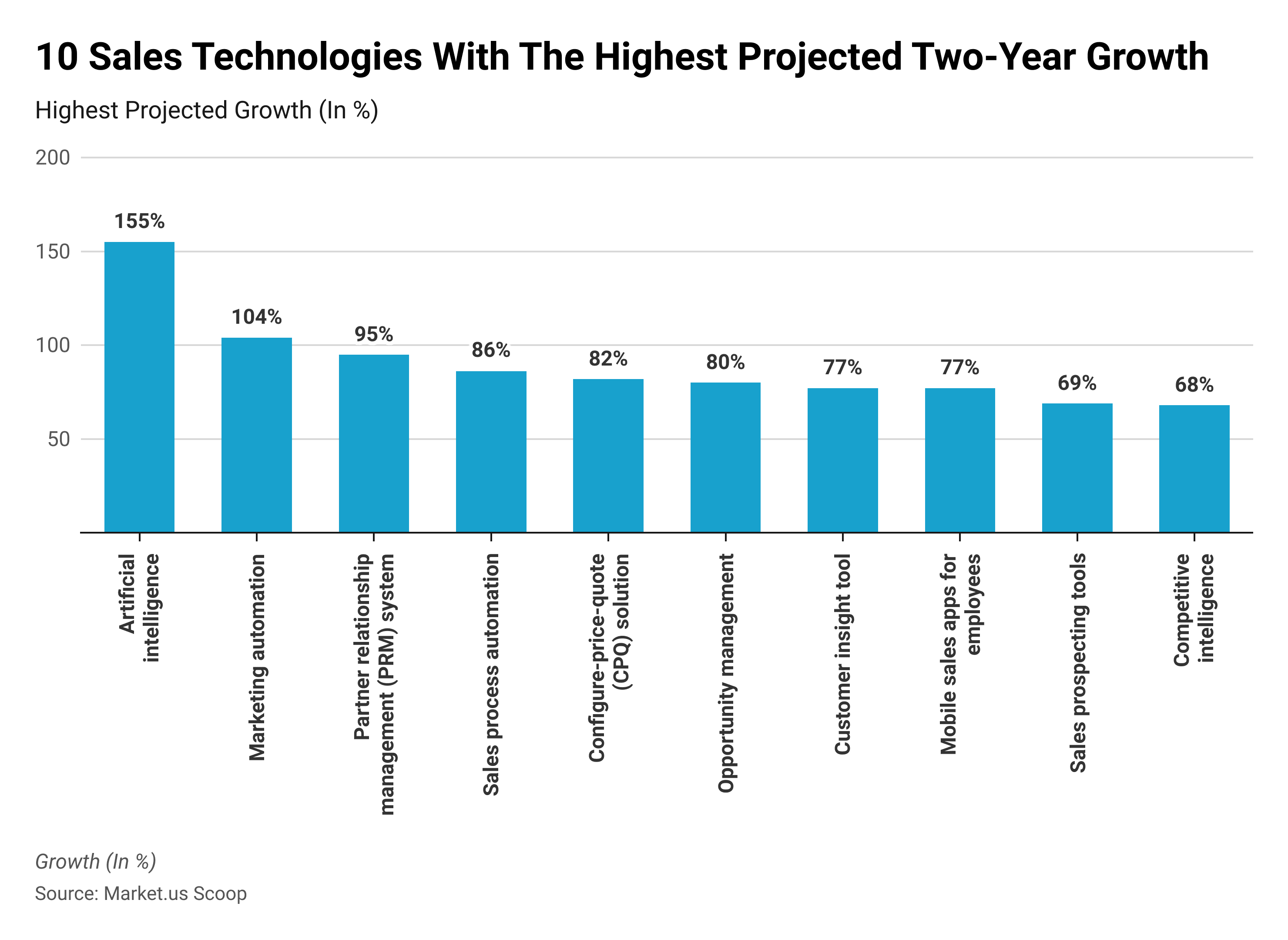
Artificial Intelligence Statistics – Usage
AI software has been found to have numerous applications both in the corporate world as well as among consumers as well. They are used to connect using mobile devices. They are available in a range of technologies, such as chatbots and voice assistants. Businesses have also reaped their benefits from such tools that have made the areas of marketing, sales, and customer service more efficient through the process.
- 55% of people cite hands-free interaction with their devices as their primary motive for making use of voice assistants.
- 22% of users report preferring using voice assistants rather than typing.
- 26% of people say they make use of voice assistants to communicate remotely to other systems.
- 39% of people claim that voice assistants respond to their commands promptly.
- The number of 4.2 billion voice assistants were incorporated into devices around the world in the year 2020.
- 75% of IT professionals in senior positions from various countries believe that implementing AI technology will increase the security of networks.
- The application of AI technology in environmental applications could help increase the growth of the employment net worldwide.
(Source: Pew Research Center 2017, Statista, 2019-2020)
Artificial Intelligence Statistics – Business
- 55% of executives agree that AI tools have improved productivity.
- A majority (48%) of those surveyed address problems with data quality by making use of data analysis machine learning, data analysis, or AI tools.
- 25% of business executives say that the adoption of AI technology has completely facilitated their processes in business.
- 50% of executives in the business said that the use of AI helped them reach their goal of cost reduction.
- 53% of companies have redesigned their products and services by using AI technology.
- 54% of CEOs are in agreement that AI plays an important role in enhancing decision-making.
- 67% of American-based businesses believe that implementing AI technology has allowed them to improve customer experience.
- 86% of executives believe that AI will become a “mainstream technology” at their workplaces by 2021.
- The slowing of AI adoption is among the main concerns of 12% of CX executives along with 11% of mainstream businesses in 2020.
- 39% of the largest companies were planning to make investments in AI or machine learning techniques in 2020, compared with 28% of conventional firms.
- Three-quarters of the largest companies plan to make investments in AI as well as machine learning in 2020. This is in contrast with 26% of mainstream businesses and 28% of CX leaders.
(Source: PwC, 2021, O’Reilly, 2020, Adobe, 2020)
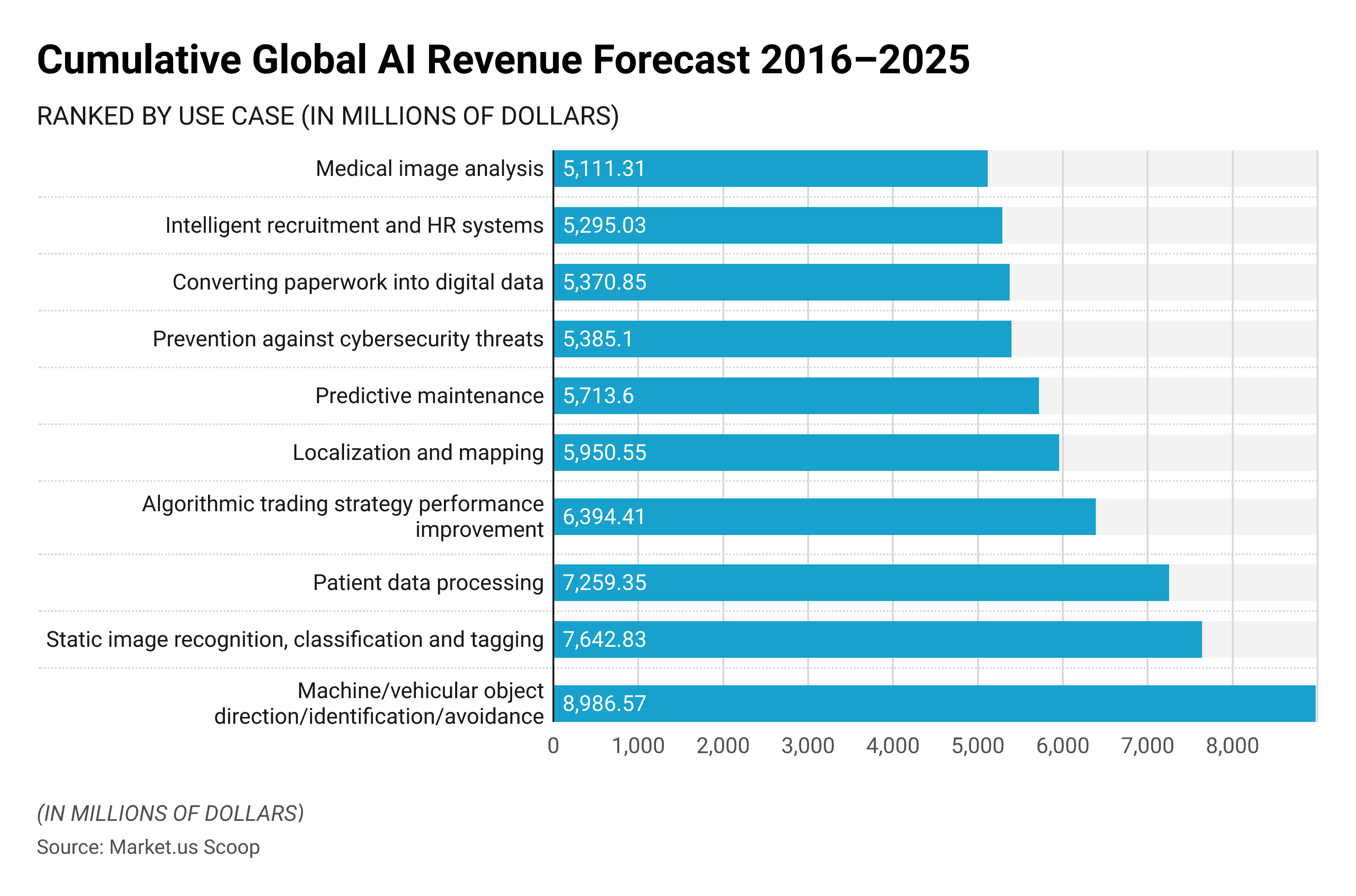
Artificial Intelligence Statistics – Sales
Companies have demonstrated that using AI significantly improves the efficiency of their selling processes. AI tools employ algorithms to provide suggestions to clients, come up with solid business forecasts, and even market their offerings through many channels, such as social media and emails. Nowadays, AI tools also allow tracking the behavior of consumers, their web-based activities, as well as preferences, allowing companies to market their services and products more efficiently. This is evident in the use of AI in business trends which indicates the widespread usage of AI.
Impact of AI Use on Sales
- 79% of respondents believe that AI use in sales and marketing has increased revenue for businesses.
- The use of AI in sales is often employed to enhance customer service analytics as well as customer segmentation.
- AI-driven strategies have helped companies produce a minimum of 20% Earnings before Taxes and Interest or EBIT.
- 10% of US jobs could disappear due to automation.
- According to sales executives, AI adoption in sales was predicted to increase to 155% by 2020.
(Source: McKinsey & Company, 2020, Forrester, 2019, Salesforce, State of Sales Report in 2018)
Artificial Intelligence Statistics – Marketing
AI has grown to be a significant aspect of marketing and has led to terms like AI marketing to describe the process. It involves using AI to aid businesses in making decisions about the best way to connect with their customers the best. The primary goal of this process is of course to improve personalization, targeting, and the customer experience. This is achieved through the use of data from customers as the basis. AI is used in the leading marketing analytics tools and typically is based on the analysis of information, search engines as well as visual recognition, image recognition in addition to sentiment analysis, as well as social listening.
- 40% of SMBs are not investing in the latest strategies to help them advance their digitalization.
- 28% of top-performing businesses make use of AI to help with marketing.
- 28% of the major organizations and 25% of CX executives have planned to put more emphasis on personalization and targeting in 2020.
- 64% of big companies make use of AI to automatize specific marketing actions, which is a huge increase of 20% from the previous year’s figure.
- 29% of the largest companies use AI as well as bot’s power campaigns and experiences. However, less than 12% of small businesses use the same.
(Source: Adobe 2018-2020)
Artificial Intelligence Statistics – Customer Service
The customer service department is a different field in which AI is helping to improve. AI is currently being utilized as a reinforcement and a replacement for human agents. The benefit of the technology is it reduces costs and enhances the experience of customers.
Numerous businesses have enjoyed this advantage by using several AI-powered software, including the top live chat applications. Although AI still has some limitations it’s now able to take care of customer queries that were previously processed by human employees. AI technology has made its way into various customer service processes, such as the routing and receiving of calls.
- 27% of customers across the world believe AI will provide superior customer service over human agents.
- 73% of the global population is in favor of the application of AI by companies, as long as they ease their lives.
- 38% of customers believe AI can improve customer service.
- 95% of customer service interaction will be made possible by AI in 2025.
(Source: PEGA, 2019, Finance Digest, 2017)
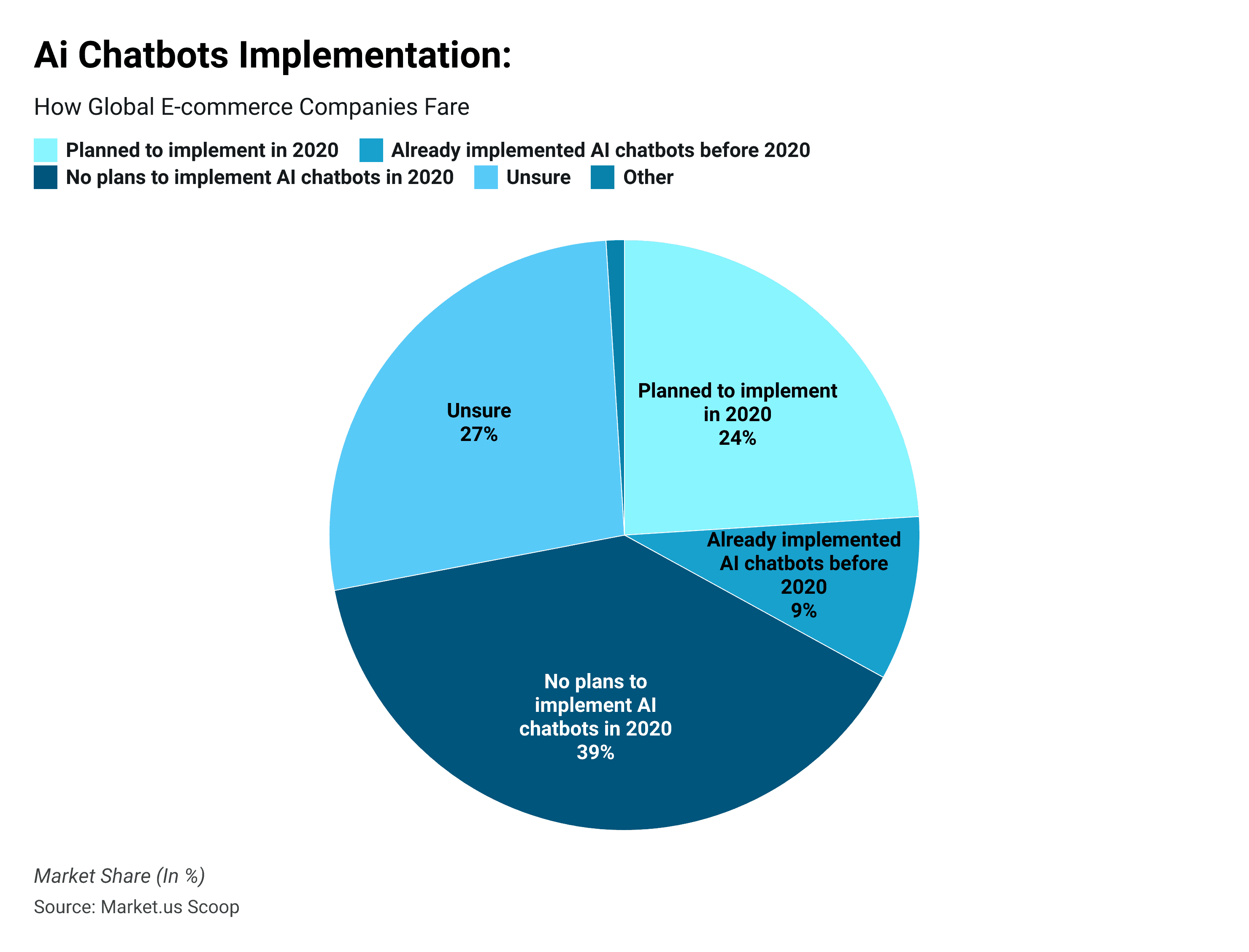
Benefits of Artificial Intelligence Adoption Statistics
The application of AI can provide a multitude of advantages, and there is no doubt about this. For businesses, AI technologies offer the benefit of automation that increases efficiency and productivity which results in higher profits and more jobs. This is evident in the ongoing expansion of the market for artificial intelligence is taking place. You can glance at the current data from CRM software to determine the way AI-powered software has performed so far. They also help humans concentrate more on important things through the automation of repetitive tasks. These and other motives for businesses to be making use of AI to improve their operations. There are some factors to be considered when buying BI software, or any other solution.
- 72% of decision-makers believe AI is the main business benefit of the future.
- 51% of CEOs say that their AI goals are to improve the features, functions, and efficiency that their software products provide.
- 63% of the global population believes that AI will help solve complicated issues in our society.
- The majority of executive executives think AI could improve the use of big data in their companies.
- Utilizing AI in the process of personalizing and segmenting customer messages can increase the click-through rate by 14%, on average.
(Source: PwC (2017,2018), Harvard Business Review 2018, EU Business School 2020)
Most Popular Artificial Intelligence Software Statistics
- Cloud Machine Learning Engine. Google’s machine learning platform can handle data of all sizes, using TensorFlow. TensorFlow framework. Find out more about the capabilities it has offered you by reading the Cloud Machine Learning Engine review.
- Azure Machine Learning Studio. Azure Machine Learning Studio. Azure Machine Learning Studio’s interaction is the main draw with drag-and-drop functions on data sets. Learn more about how it functions by reading the Azure Machine Learning Studio evaluation.
- Salesforce Einstein. An extremely powerful AI part from the Salesforce family, Salesforce Einstein analyzes and processes data to forecast trends and patterns for business. We go over what it can do inside the Salesforce Einstein review.
- IBM Watson. Watson IBM Watson IBM can be described as enterprise AI software that enables businesses to identify business opportunities using AI or machine learning. We will go over the essentials of the capabilities this AI can accomplish within the IBM Watson review.
- Apache PredictionIO. A free-of-cost AI platform that lets you publish machine-learning engines on the internet as an online service. Learn more about its capabilities in our thorough Apache PredictionIO review.
Obstacles to Artificial Intelligence Adoption Statistics
Despite the enormous benefits AI provides, a significant majority of businesses stay away from AI since they remain concerned about how it will affect their businesses. These fears, though unfounded are a normal reaction to any new technology. There is also the issue of businesses refusing to change their current processes and workflows.
- 16% of CX managers aren’t keen to switch to cloud-based services. The same is true for 15% of big corporations and 14% of SMBs.
- 4% of companies are stymied from implementing AI technology because of legal concerns as well as concerns about compliance.
- 47% of small and large companies believe that a lack of budget is a major hurdle in embracing digitalization; 30% of CX executives agree with this.
- 46% of respondents feel threatened by AI possibly disrupting their business processes.
- 23% of companies don’t recognize the necessity of AI.
- A majority of 18% think that the shortage of skilled employees holds businesses behind in using AI.
- 8.8% of businesses point to technical infrastructure issues as the primary reasons for not embracing AI technology.
(Source: Adobe, 2020, O’Reilly, 2020, PwC, 2020)
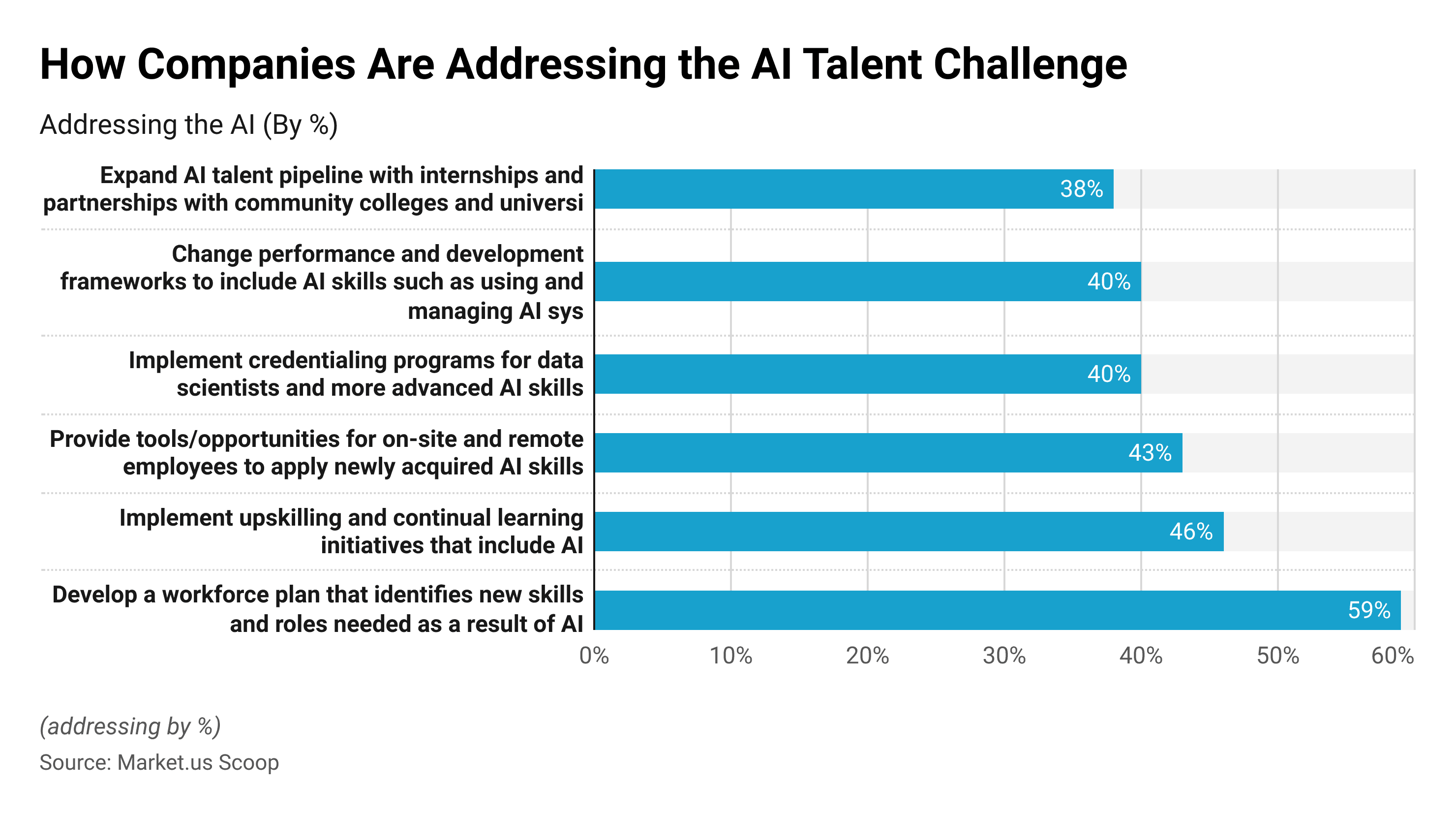
AI’s Impact on Employment Statistics
Although they are centuries removed from SkyNet today’s AI platforms have made constant progress towards making the processes completely autonomous of human involvement. But, along with these advantages can come job losses due to AI usage. Automation is becoming the norm in many aspects of business, including accounting marketing, sales, and accounting as AI developers are constantly seeking ways to increase AI capabilities for automation.
- The number is 97 million. jobs in the world created through AI from 2025.
- 85 million – the number of jobs in the world that are being eliminated by AI by 2025.
- 50 percent of employees worldwide will require retraining by 2030.
- 16 percent of US jobs could be replaced by technology like Machine Learning, AI robotics, and automated systems in 2025.
- Robots could replace 20 million manufacturing jobs by 2030.
- 36 million Americans with jobs that require exposure to automation could be able to have the majority of their jobs performed by robots in 2030.
(Source: World Economic Forum 2020, Forrester, 2019, BBC News, 2019, International Banker, 2020)
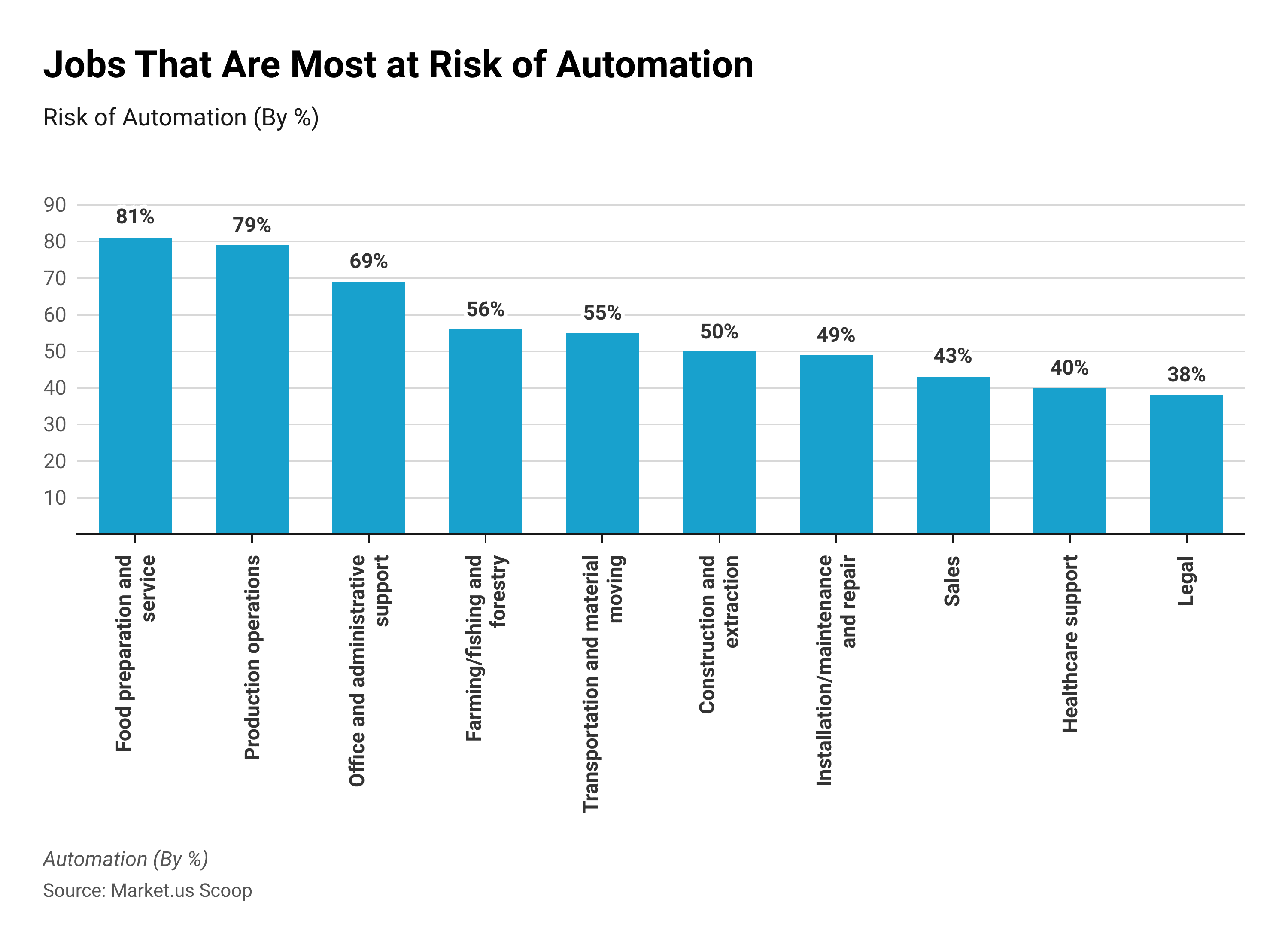
The Impact of COVID-19 on AI Adoption and Usage
The coronavirus outbreak has stopped the business activities on a worldwide scale. To fill the gap left by the reduction in the workforce, and to improve remote work processes companies are turning to AI and machine learning technologies. Although the introduction of AI has certainly been beneficial to several companies, however, there are instances when AI models could not provide the best results.
- 61% of companies that are performing well have boosted their investment in AI and machine-learning technology.
- Healthcare services and systems including pharmaceutical companies have invested more in AI and machine learning technologies the most in the wake of the outbreak.
- AI models that businesses have implemented since the pandemic have failed, particularly in the areas of sales and marketing (32 percent) products, and/or development of services (21 percent), and operational services (19 percent).
(Source: McKinsey & Company, 2020)
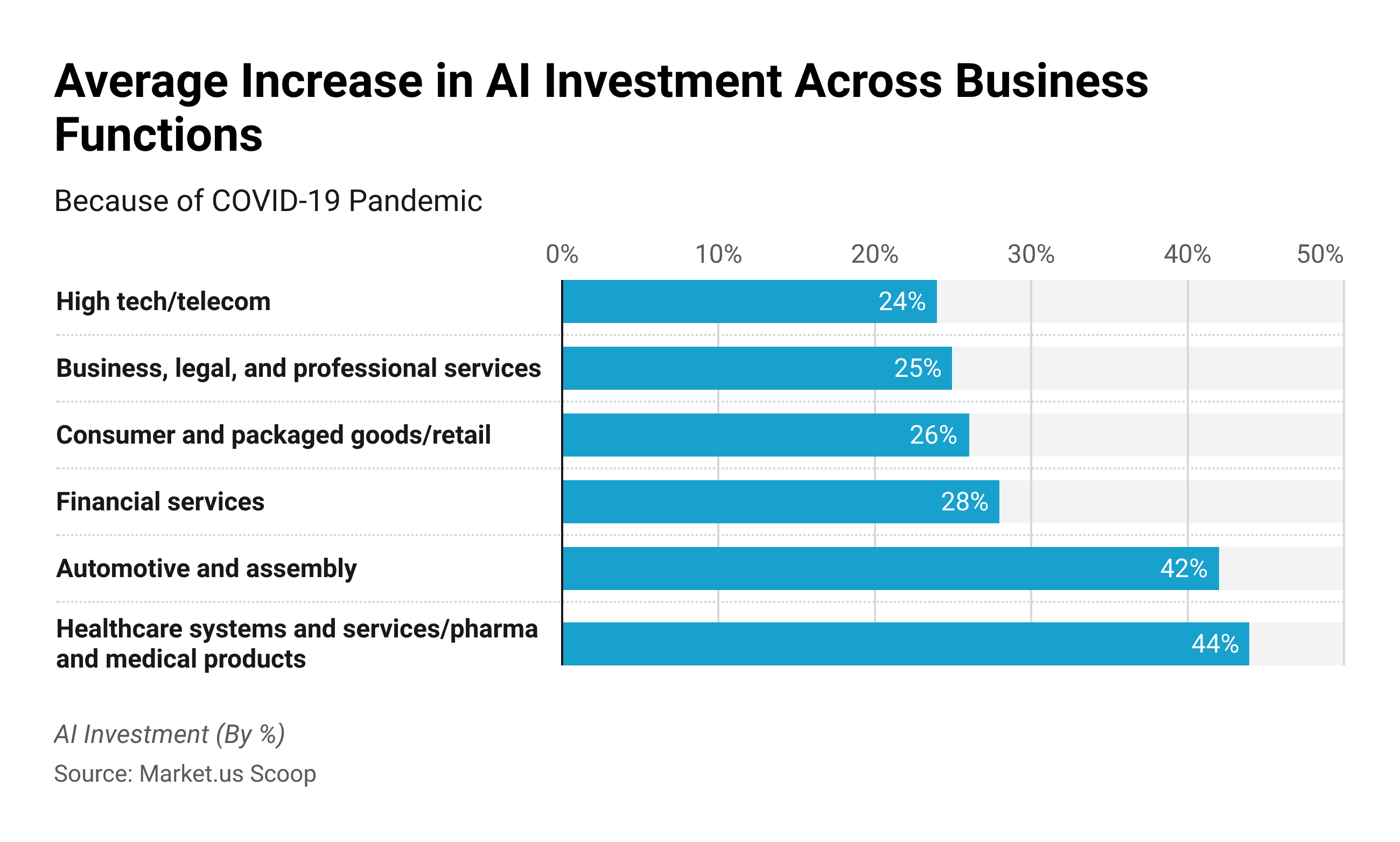
Recent Developments
Acquisitions and Mergers:
- Microsoft’s acquisition of Nuance Communications for $19.7 billion to bolster its AI capabilities in healthcare applications.
- Google’s acquisition of DeepMind, a leading AI research lab, to enhance its AI research and development efforts.
New Product Launches:
- OpenAI launched GPT-4, the latest iteration of its AI language model, promising improved natural language understanding and generation.
- IBM introduced Watson Discovery, an AI-powered platform for uncovering insights from unstructured data, catering to various industries including healthcare and finance.
Funding Rounds:
- UiPath, an AI-powered robotic process automation company, secured $750 million in Series F funding, valuing the company at $35 billion.
- DataRobot, a provider of automated machine learning tools, raised $300 million in Series G funding, demonstrating strong investor confidence in AI-driven analytics solutions.
Strategic Partnerships:
- NVIDIA partnered with Mercedes-Benz to develop a centralized computing architecture for AI-powered autonomous vehicles, aiming to revolutionize the automotive industry.
- Amazon Web Services (AWS) collaborated with Salesforce to integrate AI capabilities into Salesforce’s Customer 360 platform, enhancing customer relationship management with AI-driven insights.
Regulatory Updates:
- The European Union proposed new regulations for AI technology, aiming to ensure ethical and trustworthy AI applications while promoting innovation and competitiveness in the European market.
- The United States Federal Trade Commission (FTC) issued guidelines for companies using AI algorithms, emphasizing transparency, accountability, and fairness in AI-driven decision-making processes.
Conclusion
Artificial Intelligence Statistics – Artificial Intelligence (AI) has been able to make significant progress and has made a huge impact on the various things we do.
From enhancing efficiency in industries to improving the way we communicate and healthcare, AI has the potential to transform our lives.
AI has shown remarkable capabilities in the fields of machine learning natural language processing robotics, and computer vision.
These advances have resulted in breakthroughs in autonomous vehicles, customized medical treatments, virtual assistants, and smart home devices, in addition to numerous other applications.
But, despite its huge possibility, AI also poses challenges and raises ethical issues. One of the biggest issues is the effect of AI on employment or the overall economy.
While AI automation might eliminate some jobs, however, it has the potential to create opportunities for new jobs and increase productivity in different sectors.
FAQ’s
Artificial Intelligence refers to the simulation of human intelligence in machines that are programmed to think and learn like humans. It involves creating computer systems capable of performing tasks that would normally require human intelligence, such as problem-solving, decision-making, speech recognition, and visual perception.
AI can be broadly classified into three categories: Narrow or Weak AI: AI designed to perform specific tasks, such as voice assistants, recommendation systems, and autonomous vehicles. General or Strong AI: AI with human-level intelligence, capable of understanding and performing any intellectual task that a human being can do. Superintelligent AI: AI that surpasses human intelligence and is capable of outperforming humans in virtually every aspect.
Narrow or Weak AI: AI designed to perform specific tasks, such as voice assistants, recommendation systems, and autonomous vehicles. General or Strong AI: AI with human-level intelligence, capable of understanding and performing any intellectual task that a human being can do. Superintelligent AI: AI that surpasses human intelligence and is capable of outperforming humans in virtually every aspect.
AI has numerous applications across various industries, including Healthcare: AI can assist in disease diagnosis, drug discovery, and personalized medicine. Finance: AI is used for fraud detection, algorithmic trading, and risk assessment. Transportation: AI enables autonomous vehicles and optimizes traffic flow. Retail: AI powers recommendation systems, chatbots, and inventory management. Manufacturing: AI improves automation, quality control, and predictive maintenance.
Discuss your needs with our analyst
Please share your requirements with more details so our analyst can check if they can solve your problem(s)



